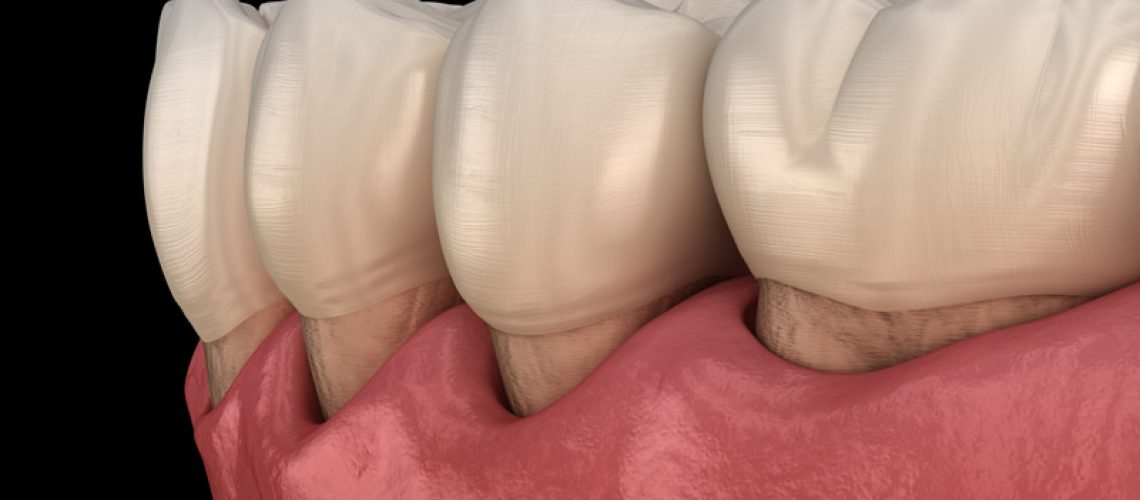In many cases of recession of the gum around your tooth or teeth, there is no question as to whether the treatment is needed, urgently. Your dentist, hygienist, and periodontist can see the problem, and you, the patient, can see the problem, and you know something must be done. Additionally, there may be tenderness when eating certain foods, or when you brush at the gumline, and there may be sensitivity to temperature or touch. There may even be an esthetic impact on your smile. In these obvious situations, it is more about finding the best periodontist that can educate you, guide you to the proper treatment option, and expertly execute the necessary periodontal plastic surgery procedure.
And then there are incidences of gum recession, or tooth root exposure that are less clear. It is in these instances that patients frequently ask us about the urgency of treatment. This question is natural because recession is often not accompanied by pain. Without discomfort, gum grafting is then viewed by many patients as an elective dental procedure, or primarily aesthetic. In fact, gum grafting is not just a cosmetic procedure; receding gums indicate underlying issues such as gum disease/bone loss, aggressive brushing habits, tooth malposition in the bone, grinding or clenching of the teeth, frenum or muscle pull, damage from habits such as smokeless tobacco, trauma from tongue/lip rings, and even genetic predisposition. While it is tempting to delay treatment, understanding the urgency of gum grafting and its proactive benefits is essential for long-term oral health and tooth retention.
Proactive treatment through gum grafting not only addresses the aesthetic concerns of receding gums, but also promotes better oral health outcomes and comfort. Furthermore, addressing gum recession early with prevention offers better healing effects. When gum grafting is performed promptly, it allows for optimal tissue regeneration, integration, and root coverage. Delaying treatment, on the other hand, can result in more extensive gum recession, requiring more complex procedures/techniques, potentially compromising the result while being more costly.
When you become a patient at Northern Virginia Periodontics to evaluate your recession, our goal is to inform you of your diagnosis, and to help you understand what it means in terms of the prognosis of your teeth. At your initial consultation, we will take digital photographs and perform a thorough examination. We rule out periodontal disease, and we measure your levels of recession, and, importantly, the quantity and quality of the soft tissues around your teeth. We also zero in on the etiology, or cause, of your gum recession. Armed with this information, we then take as much time as is needed to educate you on your specific situation. By the end of your appointment, you will feel empowered and relieved with the knowledge you have gained. And you can expect that we will either recommend treatment, not recommend treatment, or suggest a reevaluation in 1-2 years to monitor your recession.
The following are some reasons our doctors may recommend surgical gum grafting treatment:
- Stabilizing a progressing recession defect: This is the most common justification for recession treatment by periodontists
- Improving esthetics: This is the most common justification for recession treatment by patients.
- Covering unsightly exposed, dark or notched root surfaces can dramatically affect aesthetics and protect the roots moving forward.
- Prevention of continued bone loss: As your gum is receding, you are also losing critical supporting bone for your tooth, which may lead to tooth loss.
- Reducing tooth sensitivity: Exposed root surfaces can be sensitive and gum grafting can potentially cover these areas, reducing or eliminating discomfort.
- Preventing tooth decay: Exposed root surfaces are more prone to decay than enamel surfaces. Gum grafting helps protect the roots, reducing the risk of decay and associated dental problems.
- Preparing for restorative procedures: The edge of a dental restoration such as a crown, veneer, or bonding near thin gum tissue often leads to further recession, turning an esthetic restoration into an unsightly one.
- Preparing for orthodontic treatment: Tooth roots that are positioned outside of the envelope of the jawbone is the main cause of gum recession. If orthodontics push a tooth further outside of the jawbone, a gum graft prior to tooth movement can prevent recession from the positional change.
Gum recession is a common dental finding. Approximately 88% of people over the age of 65 have gum recession on one or more teeth. But the fact is that only a small percentage of gum recession actually requires treatment. Consulting with our board-certified periodontists at Northern Virginia Periodontics will help you determine exactly where you stand so that you can make an informed decision regarding your treatment needs, desires, and timelines.
Information is key to allow a decision that aligns with your oral and overall health and esthetic goals. We look forward to helping you reach a clear understanding of your condition, and if necessary, to re-achieve health and beauty in your smile.


